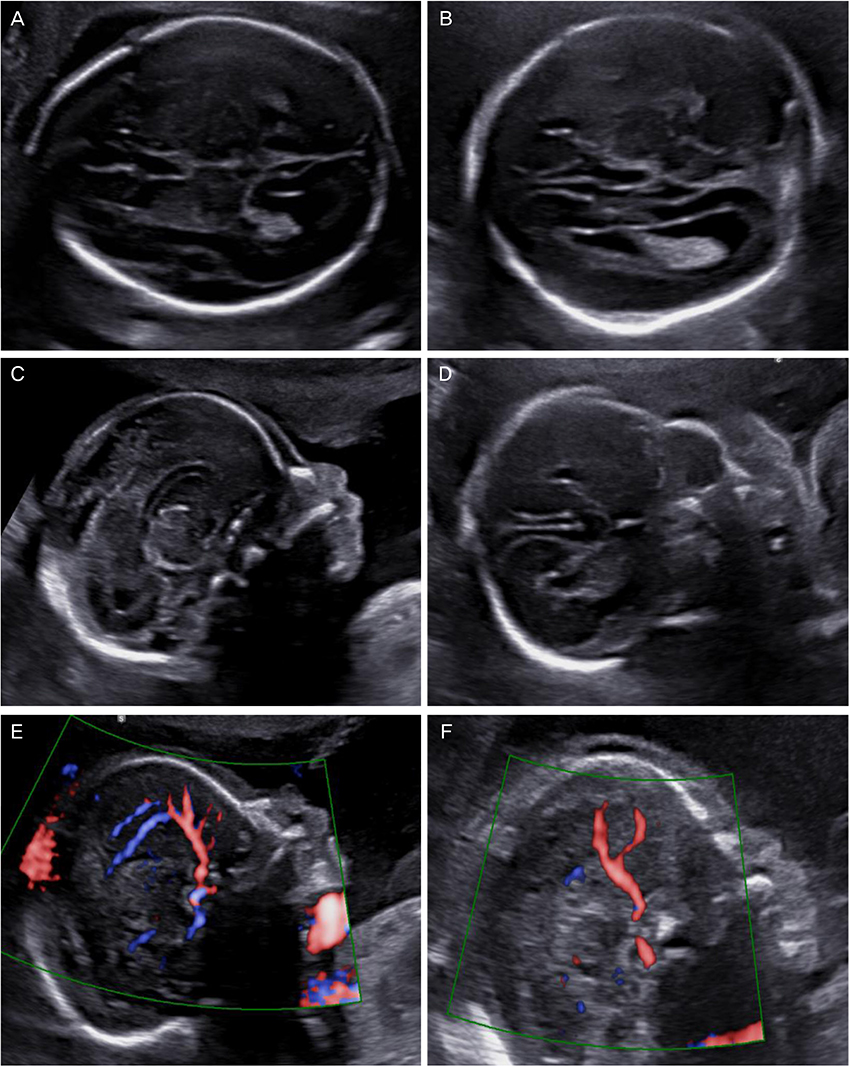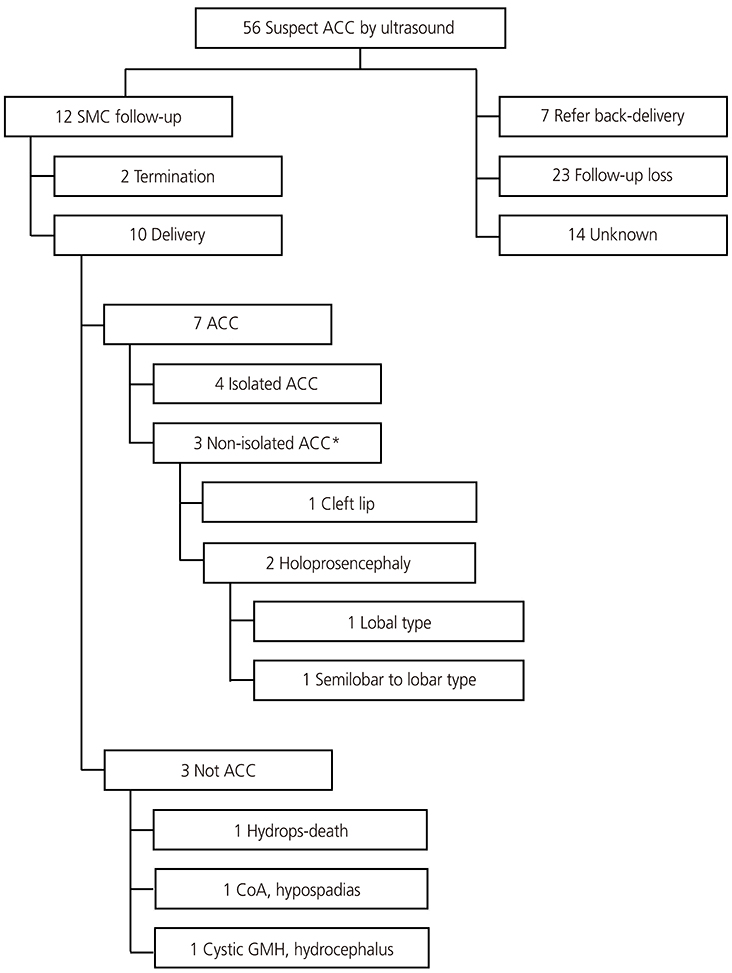Obstet Gynecol Sci.
2017 Jan;60(1):8-17. 10.5468/ogs.2017.60.1.8.
Clinical outcomes and neurodevelopmental outcome of prenatally diagnosed agenesis of corpus callosum in single center of Korea
- Affiliations
-
- 1Department of Obstetrics and Gynecology, Samsung Medical Center, Sungkyunkwan University School of Medicine, Seoul, Korea. ohsymd@skku.edu
- 2Department of Pediatrics, Samsung Medical Center, Sungkyunkwan University School of Medicine, Seoul, Korea.
- KMID: 2383202
- DOI: http://doi.org/10.5468/ogs.2017.60.1.8
Abstract
OBJECTIVE
With recent advances and frequent use of prenatal ultrasound, the antenatal diagnosis of agenesis of the corpus callosum (ACC) is not rare in obstetrics practices. However, information regarding the long-term neurological outcome remains uncertain. The aim of this study was to investigate clinical outcomes of prenatally diagnosed ACC and to analyze postnatal neurodevelopmental outcomes of ACC neonates born in our single center.
METHODS
We retrospectively reviewed 56 cases of prenatally suspected ACC referred to our center.
RESULTS
Fifty-six fetuses were diagnosed with ACC, and 12 of those were followed-up in our center until delivery. Of the remaining 44, 7 were delivered after being referred back to the original hospital, 23 were lost to follow-up, and 14 had unknown outcomes. Among all 56, 29 were considered to have isolated ACC and 27 were considered to have non-isolated ACC. Of the 10 live fetuses delivered in our center, four had isolated ACC, three had non-isolated ACC, and the rest had outcomes unrelated to ACC. Neurodevelopmental outcome was followed-up until approximately age 3 years. Of the four with isolated ACC, three (75%) had normal neurodevelopmental outcomes.
CONCLUSION
Similar to other studies, the results of our single-center study included positive neurodevelopmental outcomes for those with isolated ACC. However, despite our endeavor to counsel patients with prenatally diagnosed ACC, the delivery rate in our center was quite low. Therefore, larger, multicenter, retrospective studies including long-term neurological development outcomes are crucial and urgently needed to provide better counseling.
Keyword
MeSH Terms
Figure
Reference
-
1. Paul LK, Brown WS, Adolphs R, Tyszka JM, Richards LJ, Mukherjee P, et al. Agenesis of the corpus callosum: genetic, developmental and functional aspects of connectivity. Nat Rev Neurosci. 2007; 8:287–299.2. Engels AC, Joyeux L, Brantner C, De Keersmaecker B, De Catte L, Baud D, et al. Sonographic detection of central nervous system defects in the first trimester of pregnancy. Prenat Diagn. 2016; 36:266–273.3. Grogono JL. Children with agenesis of the corpus callosum. Dev Med Child Neurol. 1968; 10:613–616.4. d'Ercole C, Girard N, Cravello L, Boubli L, Potier A, Raybaud C, et al. Prenatal diagnosis of fetal corpus callosum agenesis by ultrasonography and magnetic resonance imaging. Prenat Diagn. 1998; 18:247–253.5. Jeret JS, Serur D, Wisniewski K, Fisch C. Frequency of agenesis of the corpus callosum in the developmentally disabled population as determined by computerized tomography. Pediatr Neurosci. 1985-1986; 12:101–103.6. Pilu G, Sandri F, Perolo A, Pittalis MC, Grisolia G, Cocchi G, et al. Sonography of fetal agenesis of the corpus callosum: a survey of 35 cases. Ultrasound Obstet Gynecol. 1993; 3:318–329.7. Volpe P, Paladini D, Resta M, Stanziano A, Salvatore M, Quarantelli M, et al. Characteristics, associations and outcome of partial agenesis of the corpus callosum in the fetus. Ultrasound Obstet Gynecol. 2006; 27:509–516.8. Moutard ML, Kieffer V, Feingold J, Lewin F, Baron JM, Adamsbaum C, et al. Isolated corpus callosum agenesis: a ten-year follow-up after prenatal diagnosis (how are the children without corpus callosum at 10 years of age?). Prenat Diagn. 2012; 32:277–283.9. Hetts SW, Sherr EH, Chao S, Gobuty S, Barkovich AJ. Anomalies of the corpus callosum: an MR analysis of the phenotypic spectrum of associated malformations. AJR Am J Roentgenol. 2006; 187:1343–1348.10. Tang PH, Bartha AI, Norton ME, Barkovich AJ, Sherr EH, Glenn OA. Agenesis of the corpus callosum: an MR imaging analysis of associated abnormalities in the fetus. AJNR Am J Neuroradiol. 2009; 30:257–263.11. Comstock CH, Culp D, Gonzalez J, Boal DB. Agenesis of the corpus callosum in the fetus: its evolution and significance. J Ultrasound Med. 1985; 4:613–616.12. Shevell MI. Clinical and diagnostic profile of agenesis of the corpus callosum. J Child Neurol. 2002; 17:896–900.13. Noguchi R, Abe K, Hamada H, Ogura T, Obata M, Miyazono Y, et al. Outcomes of patients with prenatally diagnosed agenesis of the corpus callosum in conjunction with ventriculomegaly. Arch Gynecol Obstet. 2014; 290:237–242.14. Gupta JK, Lilford RJ. Assessment and management of fetal agenesis of the corpus callosum. Prenat Diagn. 1995; 15:301–312.15. Vergani P, Ghidini A, Strobelt N, Locatelli A, Mariani S, Bertalero C, et al. Prognostic indicators in the prenatal diagnosis of agenesis of corpus callosum. Am J Obstet Gynecol. 1994; 170:753–758.16. Mangione R, Fries N, Godard P, Capron C, Mirlesse V, Lacombe D, et al. Neurodevelopmental outcome following prenatal diagnosis of an isolated anomaly of the corpus callosum. Ultrasound Obstet Gynecol. 2011; 37:290–295.17. Francesco P, Maria-Edgarda B, Giovanni P, Dandolo G, Giulio B. Prenatal diagnosis of agenesis of corpus callosum: what is the neurodevelopmental outcome? Pediatr Int. 2006; 48:298–304.18. Li Y, Estroff JA, Khwaja O, Mehta TS, Poussaint TY, Robson CD, et al. Callosal dysgenesis in fetuses with ventriculomegaly: levels of agreement between imaging modalities and postnatal outcome. Ultrasound Obstet Gynecol. 2012; 40:522–529.19. Al-Hashim AH, Blaser S, Raybaud C, MacGregor D. Corpus callosum abnormalities: neuroradiological and clinical correlations. Dev Med Child Neurol. 2016; 58:475–484.20. Sotiriadis A, Makrydimas G. Neurodevelopment after prenatal diagnosis of isolated agenesis of the corpus callosum: an integrative review. Am J Obstet Gynecol. 2012; 206:337.e1–337.e5.21. Cignini P, D'Emidio L, Padula F, Girgenti A, Battistoni S, Vigna R, et al. The role of ultrasonography in the diagnosis of fetal isolated complete agenesis of the corpus callosum: a long-term prospective study. J Matern Fetal Neonatal Med. 2010; 23:1504–1509.22. Isapof A, Kieffer V, Sacco S, Billette de Villemeur T, Gelot A, Garel C, et al. Impact of prenatal corpus callosum agenesis diagnosis on pregnancy outcome. Evaluation of 155 cases between 2000 and 2006. Arch Pediatr. 2010; 17:226–232.23. Paladini D, Pastore G, Cavallaro A, Massaro M, Nappi C. Agenesis of the fetal corpus callosum: sonographic signs change with advancing gestational age. Ultrasound Obstet Gynecol. 2013; 42:687–690.24. Ozyuncu O, Yazicioglu A, Turgal M. Antenatal diagnosis and outcome of agenesis of corpus callosum: a retrospective review of 33 cases. J Turk Ger Gynecol Assoc. 2014; 15:18–21.25. Ruland AM, Berg C, Gembruch U, Geipel A. Prenatal diagnosis of anomalies of the corpus callosum over a 13-year period. Ultraschall Med. 2015; 08. 14. [Epub]. DOI: 10.1055/s-0035-1553665.26. Rapp B, Perrotin F, Marret H, Sembely-Taveau C, Lansac J, Body G. Value of fetal cerebral magnetic resonance imaging for the prenatal diagnosis and prognosis of corpus callosum agenesis. J Gynecol Obstet Biol Reprod (Paris). 2002; 31(2 Pt 1):173–182.27. Pashaj S, Merz E. Detection of fetal corpus callosum abnormalities by means of 3D ultrasound. Ultraschall Med. 2016; 37:185–194.28. Craven I, Bradburn MJ, Griffiths PD. Antenatal diagnosis of agenesis of the corpus callosum. Clin Radiol. 2015; 70:248–253.29. Glenn OA, Goldstein RB, Li KC, Young SJ, Norton ME, Busse RF, et al. Fetal magnetic resonance imaging in the evaluation of fetuses referred for sonographically suspected abnormalities of the corpus callosum. J Ultrasound Med. 2005; 24:791–804.30. Moutard ML, Kieffer V, Feingold J, Kieffer F, Lewin F, Adamsbaum C, et al. Agenesis of corpus callosum: prenatal diagnosis and prognosis. Childs Nerv Syst. 2003; 19:471–476.31. Kim YU, Park ES, Jung S, Suh M, Choi HS, Rha DW. Clinical features and associated abnormalities in children and adolescents with corpus callosal anomalies. Ann Rehabil Med. 2014; 38:138–143.



